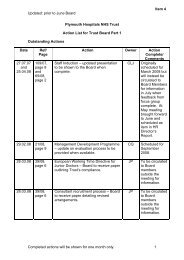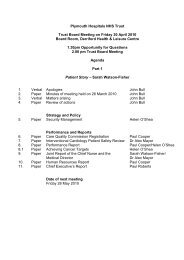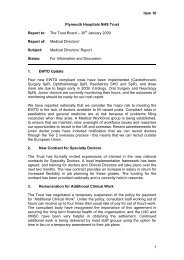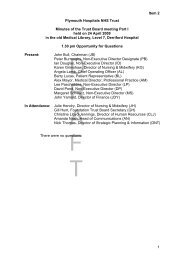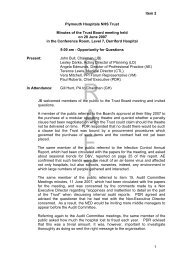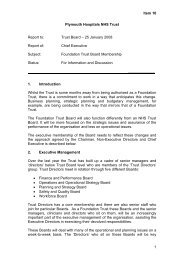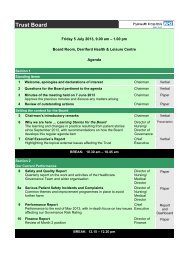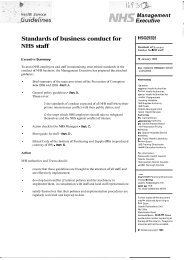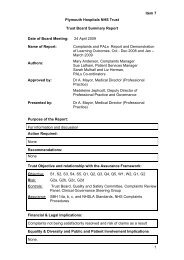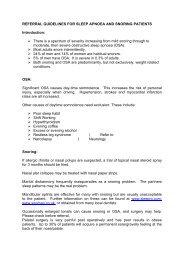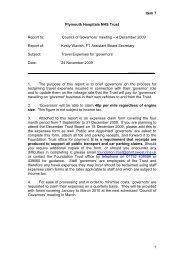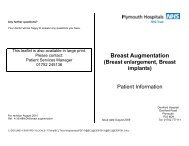Breast Reduction - Plymouth Hospitals
Breast Reduction - Plymouth Hospitals
Breast Reduction - Plymouth Hospitals
Create successful ePaper yourself
Turn your PDF publications into a flip-book with our unique Google optimized e-Paper software.
operation. In most cases the scars will fade, becoming hardly<br />
noticeable and would not be visible in normal underwear or swim<br />
wear. Scars vary enormously from one woman to the next and some<br />
people can have problems with red, raised and lumpy scars. There<br />
may be a permanent loss of sensation (normal feeling) in the nipple,<br />
breastfeeding may or may not be possible and in some rare but<br />
extreme cases the nipple may be lost altogether due to problems<br />
with its blood supply. After surgery there may be some asymmetry<br />
and there may be further changes associated with future weight<br />
fluctuations and pregnancies. A second operation for minor<br />
adjustments may be needed but can usually be performed under a<br />
local anaesthetic.<br />
Any further questions?<br />
<strong>Breast</strong> <strong>Reduction</strong><br />
Your doctor will be happy to answer any questions you have.<br />
This leaflet is also available in large print.<br />
Contact: Patient Services Manager<br />
01752 245136<br />
Patient Information<br />
For revision August 2010<br />
Ref: A-56/Plastics/DM/breast reduction<br />
Derriford Hospital<br />
Derriford Road<br />
<strong>Plymouth</strong><br />
PL6 8DH<br />
Issue date August 2009 Tel: 01752 777111
Introduction<br />
Some women have problems with asymmetry (one breast much<br />
larger than the other) or have very heavy or pendulous breasts. Very<br />
large breasts can cause back ache, neck pain and irritation of the<br />
skin underneath the breast. It can be hard to find suitable clothes<br />
and comfortable bras, and certain sports can be difficult. For some<br />
women having large breasts can make them very self-conscious or<br />
create difficulty getting clothes to fit. At Derriford Hospital, the<br />
Primary Care Trust limits who we can perform <strong>Breast</strong> <strong>Reduction</strong><br />
surgery on. The Complex Cases Panel will need to approve the<br />
funding before we are allowed to place you on the list.<br />
Who is considered for surgery?<br />
Any women with very large breasts that are problematic can be<br />
considered for a breast reduction. The size of a woman’s breasts will<br />
largely be determined by genetics but it will also be influenced by<br />
fluctuations in weight, pregnancy, breast-feeding and hormonal<br />
changes. For these reasons most surgeons advise that surgery is<br />
only undertaken when the woman’s breasts have reached maturity<br />
(ie best not performed on young teenagers) and the patient<br />
maintains a stable weight. You may be asked to lose weight to<br />
achieve a healthy BMI (body mass index) before surgery is offered.<br />
Ideally surgery should be delayed until any planned family is<br />
complete but special circumstances can be considered.<br />
What does the surgery involve?<br />
A breast reduction is usually performed under a general anaesthetic,<br />
takes between 2 and 4 hours and requires a 2 to 4 day stay in<br />
hospital. There are a number of different techniques that the surgeon<br />
can use. There may be a scar underneath the breast, one around the<br />
nipple or even a vertical scar running down from the nipple to join the<br />
scar underneath. The choice of operation will be determined by the<br />
size and shape of the breasts before surgery and the size that is<br />
desired afterwards. You should discuss the options and the exact<br />
position of the scars with your surgeon before the operation. Excess<br />
skin, fat and breast tissue is removed and the position of the nipple<br />
may be moved permanently. Before the operation, depending on<br />
your age and fitness, you may have to undergo some simple health<br />
checks such as blood tests and a mammogram. The surgeon will<br />
also examine your breasts and draw guidelines with a marker pen<br />
before you are under the anaesthetic. If you decide on surgery you<br />
will be required to sign a consent form giving permission for the<br />
operation. This requires that you are aware of the risks and<br />
complications involved with the procedure.<br />
What will happen in the recovery period?<br />
When you come round from the anaesthetic you will be heavily<br />
bandaged and have drainage tubes in place. The drains can usually<br />
be removed a day or so after the operation, but occasionally will be<br />
left for a little longer if fluid continues to leak. You may have<br />
dissolvable stitches but any permanent stitches that are used will<br />
need to be removed approximately 10 days after the surgery. You<br />
should expect lumpiness and tenderness for some weeks or maybe<br />
months after the operation.<br />
What is the recovery time?<br />
You will be advised to wear a supportive bra day and night and<br />
should not drive or undertake any vigorous activity for up to 6 weeks.<br />
Depending on your job, you should be able to return to work 2 to 4<br />
weeks after the operation.<br />
Are there any complications?<br />
There are general risks associated with a general anaesthetic<br />
including chest infection and DVTs (clots in the veins of the legs).<br />
There are risks specific to breast surgery. Bleeding, sometimes<br />
requiring a blood transfusion occasionally happens. Problems with<br />
wound healing and infection can occur, particularly in those who<br />
smoke, and it is therefore advisable to stop smoking before the



